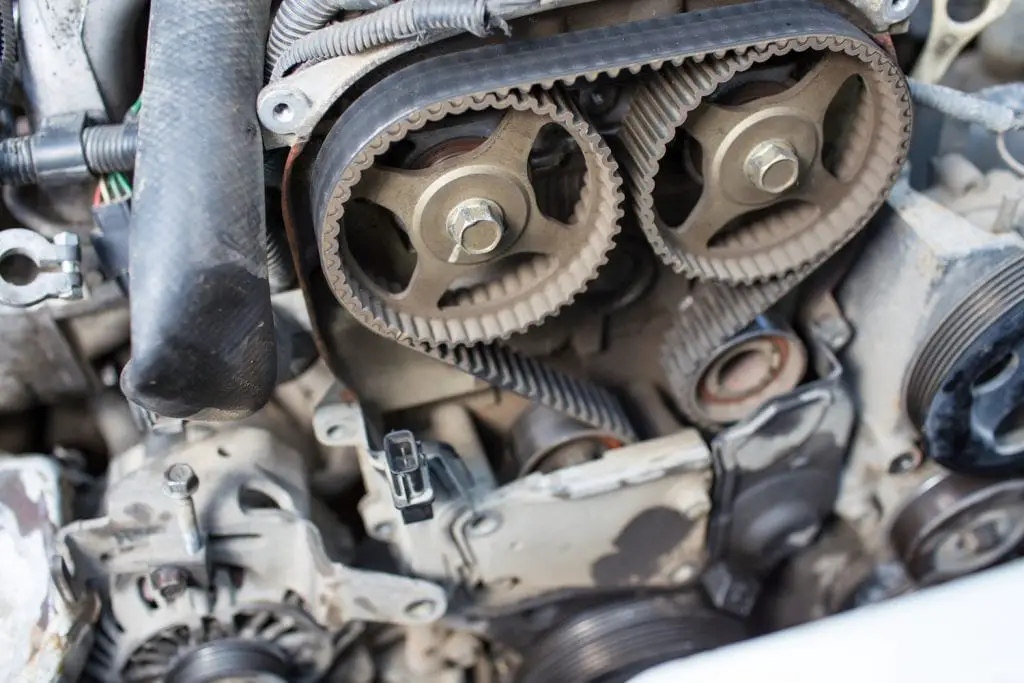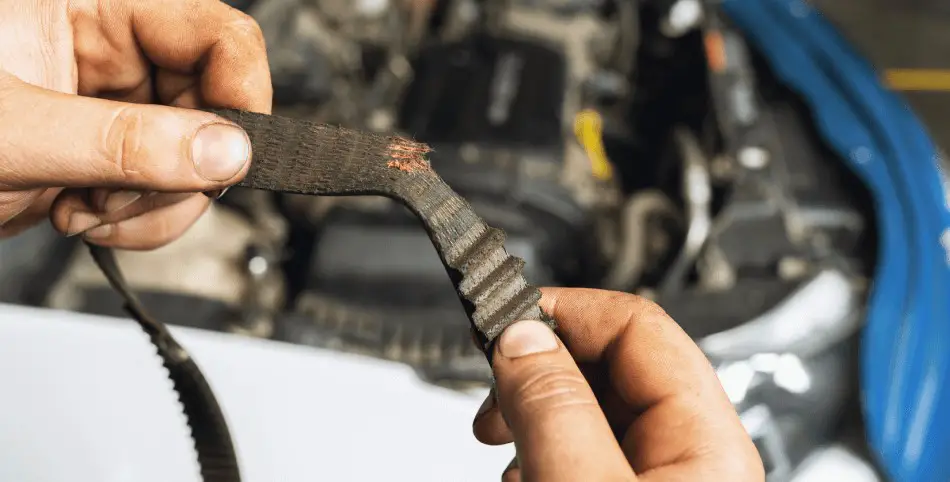Bad timing belt symptoms include ticking noises, misfires, difficulty starting, and visible wear. Ignoring these signs can cause severe engine damage, so replace it promptly.
A vehicle’s timing belt is one of its most critical components, ensuring the engine runs smoothly and efficiently. This often-overlooked part coordinates the rotation of the crankshaft and camshaft, ensuring the engine’s valves open and close at precisely the right times.
However, a failing timing belt can lead to severe engine damage, costly repairs, or even complete breakdowns. Recognizing the symptoms of a bad timing belt early can save you from unexpected expenses and safety risks.

Contents
What Is a Timing Belt, and Why Is It Important?
The timing belt, often made of reinforced rubber with nylon fibers, plays a pivotal role in your engine’s operation. It connects the crankshaft to the camshaft, synchronizing their movements. This synchronization ensures that the engine’s intake and exhaust valves open and close at the right time in relation to the piston’s movement.
A malfunctioning timing belt can disrupt this process, leading to poor engine performance, misfires, or worse—complete engine failure.
Common Symptoms of a Bad Timing Belt
A bad timing belt can cause a variety of issues in your vehicle. Common symptoms include:
1. Ticking Noise from the Engine
One of the earliest signs of a failing timing belt is a ticking or clicking sound coming from the engine. This noise occurs because the belt’s tension weakens, causing improper synchronization between engine components. While ticking noises can also indicate low oil pressure or valve issues, it’s wise to inspect the timing belt if you hear this sound.
2. Engine Misfires
A worn or stretched timing belt can cause the engine’s cylinders to open and close at incorrect intervals, leading to engine misfires. Engine misfires can result in poor performance, reduced fuel efficiency, and a rough driving experience.
3. Difficulty Starting the Engine
If the timing belt is severely worn or has slipped, the engine’s timing will be off, making it difficult to start the vehicle. In extreme cases, the engine might not start at all.
4. Visible Wear or Damage on the Timing Belt
Regular inspections can reveal signs of wear, such as fraying, cracks, or glazing on the timing belt’s surface. If you notice any visible damage, it’s essential to replace the belt immediately to avoid a breakdown.
5. Engine Overheating
A failing timing belt can interfere with the water pump’s operation, which may cause the engine to overheat. Persistent overheating can lead to severe engine damage, including a blown head gasket.
6. Loss of Power or Poor Acceleration
A slipping or worn timing belt may cause the engine to lose power, especially when accelerating. If you notice sluggish performance or hesitation, it’s worth investigating the timing belt’s condition.
7. Unusual Exhaust Smoke
Excessive exhaust smoke, especially if it’s blue or white, can indicate that the timing belt is out of sync, leading to improper combustion. This symptom often accompanies other performance issues.
8. Check Engine Light
While the check engine light can illuminate for various reasons, a failing timing belt is one possible cause. Modern vehicles are equipped with sensors that monitor engine timing. If the belt is slipping or worn, it may trigger this warning.
Consequences of Ignoring a Bad Timing Belt
Ignoring the symptoms of a failing timing belt can lead to severe consequences, including:
- Engine Damage: If the timing belt snaps while driving, the pistons and valves can collide, causing catastrophic engine damage.
- Costly Repairs: Repairing or replacing an engine damaged by a broken timing belt can cost thousands of dollars.
- Safety Risks: A sudden engine failure while driving can be dangerous, especially at high speeds.
- Stranded Vehicle: A broken timing belt can leave you stranded, requiring a tow and emergency repairs.
When Should You Replace a Timing Belt?
Timing belt replacement intervals vary depending on the vehicle’s make and model, but they typically range from 60,000 to 100,000 miles. Consult your owner’s manual for specific recommendations. Additionally, if you purchase a used vehicle and are unsure of its maintenance history, it’s wise to have the timing belt inspected and replaced if necessary.

Preventive Maintenance Tips
To prevent issues with the timing belt, follow these maintenance tips:
- Regular Inspections: Have your timing belt inspected during routine maintenance. Look for visible signs of wear or damage.
- Follow Manufacturer Recommendations: Replace the timing belt at the recommended intervals to avoid unexpected failures.
- Check Related Components: When replacing the timing belt, consider replacing the water pump, tensioners, and pulleys simultaneously. These components work together and often wear out at similar rates.
- Listen for Warning Signs: Pay attention to unusual engine noises, performance issues, or other symptoms listed above.
Frequently Asked Questions
Here are some FAQs about bad timing belt symptoms –
1. What Happens if a Timing Belt Breaks While Driving?
If a timing belt breaks while the engine is running, the valves and pistons can collide, causing extensive engine damage. In some cases, the engine may be irreparably damaged, requiring a complete replacement.
2. How Much Does It Cost to Replace a Timing Belt?
Timing belt replacement costs vary depending on the vehicle’s make and model but typically range from $300 to $1,000. This cost includes parts and labor. Replacing related components, such as the water pump, may increase the total cost.
3. Can I Drive with a Bad Timing Belt?
Driving with a bad timing belt is risky and can lead to sudden engine failure. If you suspect your timing belt is failing, have it inspected and replaced as soon as possible.
4. Is a Timing Belt the Same as a Timing Chain?
No, a timing belt and a timing chain serve the same purpose but are different components. Timing belts are made of rubber and require periodic replacement, while timing chains are metal and generally last longer. However, timing chains can also fail and require maintenance.
5. How Do I Know If My Timing Belt Needs Replacement?
Look for symptoms such as engine misfires, ticking noises, difficulty starting, or visible wear on the belt. Additionally, follow your vehicle manufacturer’s recommended replacement intervals.
Conclusion
A failing timing belt can lead to significant engine damage and costly repairs if not addressed promptly. By recognizing the symptoms early, following the manufacturer’s maintenance schedule, and addressing issues as they arise, you can ensure your vehicle remains reliable and safe on the road.